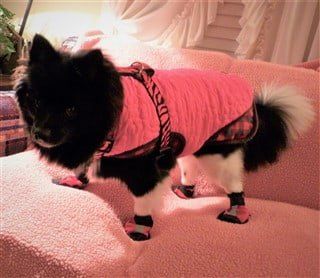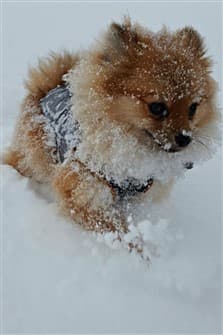Winter Care
PetPom

The
Pomeranian
Information
Center
Pomeranian Winter Care Tips

Serenity, photo courtesy of Penny & Randy Ketterman
Overview
Although the Pomeranian is a Spitz breed that descended from arctic sled dogs, the toy breed we have today needs some extra care during the winter. This article covers the top wintertime tips to keep a Pomeranian safe, comfortable, warm, and healthy no matter how cold or snowy it is.
Tip #1 Protect your Pom's paws.
Winter can be really rough on a Pom's paws.
- Just walking on frozen ground can have a drying effect.
- Road salt or sand and ice-melt products can cause contact irritations.
- Snowballing is common (snow melts between the toes and/or paw pads, then quickly refreezes into ice and stretches the sensitive skin there)
- Dogs often lose traction due to ice and snow
Fortunately, there's one product that can resolve all of these winter-related issues: paw wax. We recommend Musher's Secret Pet Paw Protection Wax
 which should be applied about once every 2 weeks. This absorbs pretty fast, but it's still best to massage it in at night right before your Pom is ready to go to sleep. If the paws are already dry, peeling, or slightly to moderately cracked, this can also help repair damage.
which should be applied about once every 2 weeks. This absorbs pretty fast, but it's still best to massage it in at night right before your Pom is ready to go to sleep. If the paws are already dry, peeling, or slightly to moderately cracked, this can also help repair damage.
Tip #2 Consider a winter coat for your Pom during cold or wet weather.
Adult Pomeranians have double-layered coats of fur (young pups have just one) that works to some extent in keeping them warm. But, it can only do so much. When temps plummet down to near or below freezing, if there are cold winds, and/or with wet or wintry precipitation, a Pomeranian may have little tolerance for outdoor conditions. This can affect everything from potty needs to exercise requirements (details on both, coming up).
So, placing a water-proof and ideally wind-proof coat on your Pom can be just the thing to help your little guy or gal be okay with heading outside in the winter.
If you're looking for a winter jacket for your Pom, you may want to check out the Kuoser Cozy British-Style Plaid Winter Coat . This starts in size xx-small for young pups, so there's a size for every Pomeranian. This is reversible, with a wind and water-proof outer shell and a super-warm and soft fleece layer on the opposite side.
. This starts in size xx-small for young pups, so there's a size for every Pomeranian. This is reversible, with a wind and water-proof outer shell and a super-warm and soft fleece layer on the opposite side.
There's elastic and Velcro on the tummy panel for a custom fit and it comes in all types of colors for both boy and girl dogs.
This is Foxie, bundled up and ready to tackle anything that winter throws her way!
Photo courtesy of Brenda
Tip #3 Keep up with exercise requirements.
Regular exercise is incredibly beneficial for dogs. On a basic physical level, it helps keep the heart healthy, helps maintain proper muscle mass, helps regulate the metabolism, is thought to help keep the immune system strong, and is even linked to helping to prevent some forms of cancer in dogs.
It also has mental health benefits as well. Canines can suffer from two ailments in the winter: the canine equivalents of both cabin fever (restlessness from staying inside too much) and seasonal affective disorder (depression linked to a decrease in sunlight hours).
So, unless there is very inclement weather, take your Pomeranian out for at least two brisk walks per day. The aforementioned paw wax and winter coat will help with that. And, on days with dangerous winter weather (well-below freezing temps, snowstorms, etc.) plan for some indoor exercise for your Pom. If you have a hallway, open floor plan, or even just a largish room, two timed 20-minute games of indoor fetch with a toy like the Chuckit! Indoor Ball for Small Dogs
 can at least offer some cardio.
can at least offer some cardio.
Tip:
Stop the game before your Pom gets tired of it and is still having fun. You can signal the end with a small training treat and praise. This will help your Pom look forward to the next session.
Tip #4 Address dry air issues.
Air is much dryer in the wintertime because cold air is not able to hold onto moisture as warmer air can. Heating the air up in your house does not add in any moisture, in fact it can make it even dryer.
Arid air takes moisture from anywhere it can. Commonly, this means from a dog's (or a person's) skin. So, the deeper you get into winter, the more issues there can be with dry skin. When a Pomeranian's skin becomes dry, typical symptoms include itchiness and discomfort.
If this is left to resolve on it's own, it can take a very long time. And, without proper treatment, drying can easily snowball into peeling, cracking, and other more serious issues. So, this is another Pomeranian winter care tip that it is best to be proactive about.
To help prevent dry air issues, aim to keep the humidity level between 35 and 45%. The most effective method to accomplish this is with a humidifier. Ideally, you'd have enough to cover the house. If you only have one or two, set these up near your Pom's resting and/or playing areas.
Something like the Homasy Cool Mist Humidifier
 covers a large room and runs about 24 hours on one refill.
covers a large room and runs about 24 hours on one refill.
Lola, photo courtesy of Zara
Tip #5 Plan in advance for potty needs during bad weather.
If your Pom normally goes potty outside (our recommended method), this may prove tricky during really bad winter weather. Here's some tips that can help:
- Have the designated area as close to the house as possible and ideally at least partially sheltered by shrubbery, the house itself, an outdoor umbrella, and/or other means.
- Shovel a pathway as it snows, to keep on top of this.
- Consider creating an indoor potty area to use during snow storms and/or freezing temperatures. For Poms that are used to heading outside, it can help to set this up in an attached garage, mudroom, or other area away from the normal living space. Bring your Pom there on a leash and offer praise and reward once the deed is done to reinforce the idea of this new temporary potty method.
Tip #6 Keep tabs on the nose.
With no natural protection, a dog's nose can very quickly become chapped in the winter. It starts with a bit of dry nose skin, a dog then licks at their nose more than normal, the saliva further irritates things, and once outside a wet irritated nose can quickly get chapped from cold winds.
With black and other dark-pigmented nose colors, it can be difficult to spot this issue. Often, it won't be noticed until it's so sore and raw that a Pom is licking at it near constantly or there is severe peeling or cracking.
This sort of issue can be prevented by applying a nose balm about once a week. And, if the nose is already irritated, a good nose balm can work to heal it (note that if cracks are so deep, it is bleeding or these is a pus-like discharge, this requires veterinary treatment). We recommend Natural Dog Company's Snout Soother
 which contains a blend of all organic ingredients to add a layer of protection and to heal peeling, cracking, and chapping.
which contains a blend of all organic ingredients to add a layer of protection and to heal peeling, cracking, and chapping.
Kota, at 1.5 years old, photo courtesy of Lydia May from Virginia
Tip #7 Check the house for drafts.
Sometimes it's easy to forget that what our Poms experience down near the floor can be quite different than what us humans perceive from up above. Walls (especially near electrical outlets) and areas near windows and doors can get very chilly or have uncomfortable drafts. Hardwood floors can be rather cold as well.
It can help to get down on your Pom's level to inspect things. If you do notice these things and cannot correct them, move your Pom's resting, playing, or other areas to warmer, more comfortable spots.
Tip #8 Playing in the snow.
While some Poms dislike the snow, others can't get enough of it. If your Pom does enjoy playing in the snow, just be sure to supervise and time these play sessions.
Dogs often push themselves beyond the point of when hypothermia starts to set in, so outdoor snow play should be limited (but this will vary depending on the temperature and whether the snow is more dry or wet).
For puppies (that have had all of their puppy shots and can spend time outside), tolerance will be low, so sessions should be kept very short, just 5 minutes or so. For adult Pomeranians, 20 minutes or so is usually the limit; but if you notice that snow is melting into your Pom's coat or your little guy or gal is otherwise getting wet, end things early.
Bella Mia and Kody, photo courtesy of Marilyn Wetter
Tip #9 Brushing the coat on a regular basis.
As winter winds down, there is often a heavy shed. But, you don't want to wait until then to start dealing with things. Lots of dead hairs left in the coat can lead to a tangled, packed mess in which skin pores become blocked. This can lead to funky smells and even skin yeast infections.
At least once a week during the winter, go over the entire coat with a quality slicker brush. One that we like is the PETPAWJOY Slicker Brush
 which is ideally sized for Poms, and has comfort tips and a swivel mechanism to make brushing much easier.
which is ideally sized for Poms, and has comfort tips and a swivel mechanism to make brushing much easier.
Once winter is done and the spring shed begins, use a rake comb like the Nomad Dog Rake Deshedding Comb
 to help pull out all of the dead, shedded hairs. Note that there are different types of rake combs; you want to use a stationary fixed comb (non-rotating) and not
a spinning rotating one.
to help pull out all of the dead, shedded hairs. Note that there are different types of rake combs; you want to use a stationary fixed comb (non-rotating) and not
a spinning rotating one.
A Final Word
Winter can certainly bring about some issues for our canine family members. But, with a bit of prepping and some adjustments, you can avoid the most common winter-related problems. And, before you know it, spring will be here.
You may also like:
Pomeranian Summer Care Tips
- Hot sunny weather brings about its own set of obstacles. See our top tips to keep a Pom comfortable and cool during the summertime.
Toys for Pomeranians
- Our top picks in all toy categories. If you think of toys as being tools, the right ones can solve a number of problems.
How to Keep a Pomeranian Clean
- Tips for keeping a Pom looking tidy and smelling nice.
Are you a site member?
Become a free PetPom Member; this will allow you to receive our newsletter, be the first to know about fun events like surveys and photo call-outs, and submit pictures that may be posted to this site.
Do you have your book?
If you have a Pom, you'll love PetPom's GIANT Book of Pomeranian Care; it's the most comprehensive book of its kind.
If you email photos to us, you agree that PetPom is given free copyright to use at our discretion. We will always credit the photo to the name of the Pom's owner(s) if it is supplied.
Email: Contact@PetPom.com
All text, images and artwork protected by US and International copyright laws. All rights reserved. Copyright PetPom.com
We are a participant in the Amazon Services LLC Associates Program, an affiliate advertising program designed to provide a means for us to earn fees by linking to Amazon.com and affiliated sites.




